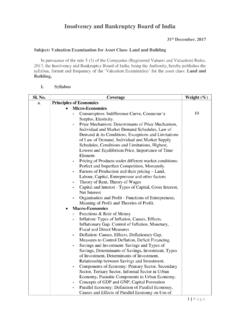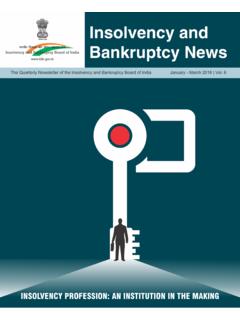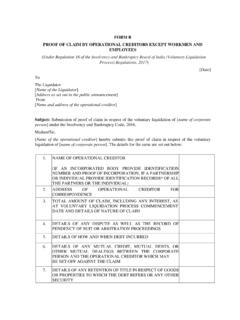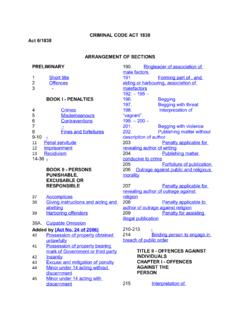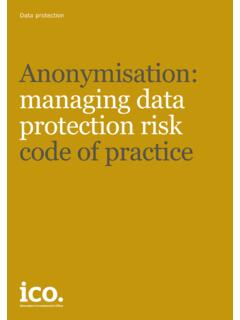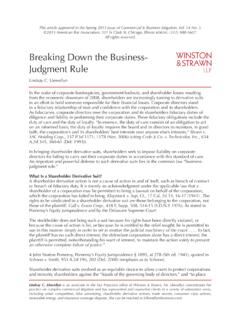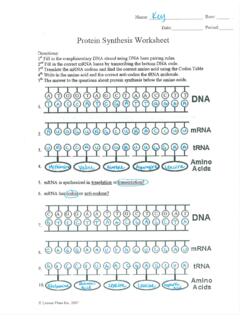Transcription of The report of the Bankruptcy Law Reforms Committee …
1 The report of the Bankruptcy Law Reforms Committee Volume I: Rationale and Design November 2015 Contents 1 Acknowledgements .. 7 2 Executive summary .. 10 3 Economic thinking .. 18 Why Reforms ? 18 The role that insolvency and Bankruptcy plays in debt financing 20 Assessing viability .. 21 Conflicts in creditor-debtor negotiation .. 21 What can a sound Bankruptcy law achieve? .. 22 Present arrangements in India 24 Difficulties of the present arrangement .. 25 Features of the proposed code 29 Objectives .. 29 Principles driving the design .. 29 Design of the proposed 31 How India will benefit from Reforms of the Bankruptcy process 33 4 Institutional infrastructure .. 35 Insolvency Regulator 35 The case for a regulator.
2 35 Establishing the Insolvency Regulator .. 36 Objectives of the regulator .. 36 Functions of the regulator .. 37 Statistical and research functions .. 37 Accountability mechanisms .. 38 Governance arrangement .. 39 Process for legislative functions .. 39 Process for executive functions .. 40 Process for quasi-judicial function .. 41 Framework for penalties .. 42 Appeals against actions of the regulator .. 42 Obtaining resources and spending them .. 42 The Bankruptcy and Insolvency Adjudicator 44 Tribunals .. 44 Territorial jurisdiction .. 45 Procedural rules .. 46 Essential features .. 47 Bankruptcy and Insolvency Information Utilities 51 Bankruptcy and insolvency information utilities .. 51 Information requirements for insolvency and Bankruptcy resolution.
3 53 Information about the liabilities of a solvent entity .. 54 Information about operational creditors .. 55 Information of default or restructuring .. 58 Information about secured assets .. 59 Rules about privacy of information in an IU .. 60 Rules on revealing creditor identities .. 60 Open industry-standard APIs .. 61 An information-rich environment .. 61 Analogies with FSLRC s treatment of resolution .. 62 The Insolvency Professionals 63 Mandates for IPs .. 64 Entry Requirements for IPs .. 65 IP Regulatory Structure .. 66 The role of the IP agencies .. 66 The role of the Regulator with regard to IP agencies and IPs .. 71 5 Process for legal entities .. 73 A single code for all legal entities 76 The calm period of the Insolvency Resolution Process, IRP 76 Who can trigger the IRP?
4 76 How can the IRP be triggered? .. 77 Process flow of the IRP 80 Steps at the start of the IRP .. 81 The role of the Resolution Professional .. 86 Obtaining the resolution to insolvency in the IRP .. 89 Rules to close the IRP .. 91 Fast-track IRP 92 A time-bound, efficient Liquidation 93 What can trigger Liquidation? .. 95 Rules to accept the trigger to Liquidation .. 96 Steps at the start of the Liquidation .. 96 Establishing the irreversibility of Liquidation .. 100 Establishing assets in Liquidation .. 100 Right of the secured creditors to withdraw from collective Liquidation 101 Realisation in Liquidation other than through sale of assets .. 101 Establishing priority of payout in Liquidation .. 103 The role of the liquidator.
5 105 Rules to close the Liquidation .. 108 Actions against frauds, malpractice and other wrongs 110 Actions during the IRP .. 111 Actions/Appeals after the IRP .. 112 Penalties 112 6 Process for individuals .. 114 The applicability of the code 116 Overall procedure 117 Triggering insolvency 117 Who can trigger insolvency? .. 117 What is the process for triggering insolvency? .. 120 Effect of filing an application at the Adjudicator .. 120 The process for acceptance of the Application .. 121 The process after acceptance of the application 124 Moratorium period .. 124 The process of negotiation .. 125 Implementation of the repayment plan .. 127 Restrictions on the debtor ..129 Replacement of the resolution professional .. 129 Bankruptcy proceedings 130 Bankruptcy application.
6 131 Effect of the application .. 131 Effect of the Bankruptcy order .. 131 Restrictions on the bankrupt .. 134 Functions of the Trustee .. 134 Assets in Bankruptcy .. 135 Administration of the estate .. 137 Priority of payout .. 138 Rules to close Bankruptcy .. 139 Annulment .. 140 Discharge 140 FSO .. 141 IRP .. 141 Bankruptcy .. 141 Offences 142 Appeals 143 7 Repeals and savings .. 144 Laws dealing with Bankruptcy and insolvency 146 Laws dealing with recovery of dues 146 Laws that may impact procedures under the proposed code 146 Subordinate legislation that interface with the code 147 Interfaces with the draft Indian Financial code 147 8 Implementation .. 149 Constructing the regulator 149 Information utilities 150 Insolvency profession 151 Adjudication infrastructure 152 Transition Provision 152 Summary 153 9 Office Order setting up the BLRC 154 Office Order Revising Composition of the BLRC 155 1 Acknowledgements As Chairman of the Committee on Bankruptcy law Reforms , I have had the privilege of overseeing the design and drafting of a new legal framework for resolving matters of insolvency and Bankruptcy .
7 This is a matter of critic al importance: India is one of the youngest republics in the world, with a high concentration of the most dynamic entrepreneurs. Yet these game changers and growth drivers are crippled by an environment that takes some of the longest times and highest costs by world standards to resolve any problems that arise while repaying dues on debt. This problem leads to grave consequences: India has some of the lowest credit compared to the size of the economy. This is a troublesome state to be in, particularly for a young emerging economy with the entrepreneurial dynamism of India. Such dynamism not only needs Reforms , but Reforms done urgently. The Committee was seized of this, and focused on a two-phase mandate over its tenure. The first phase was to examine the existing Bankruptcy framework, and whether there were policy and legal changes that could yield immediate effect.
8 The focus here was on the problems of insolvency and Bankruptcy under the Companies Act, 2013. The outcome of the deliberations of the Committee led to the Interim report of the Committee that was put out for public comments at the end of February, 2015 (Ministry of Finance, 2015). The team at the Vidhi Centre for Legal Policy, led by Debanshu Mukherjee, did a wonderful job to deliver the richly detailed report within the hard limitations on time. The Committee then embarked on the second phase of its mandate. Here, the task was to create a uniform framework that would cover matters of insolvency and Bankruptcy of all legal entities and individuals, save those entities with a dominantly financial function. This shifted the mandate to a much wider problem that included micro, small and medium enterprises, sole proprietorships and individuals.
9 This also meant demands on a much wider and deeper base of knowledge, on both matters of the economics of the problem as well as the legal framework. Fortunately for the Committee , we had ample help from various sources to tackle both of these issues. A sub-group of the Committee including Aparna Ravi, Sudarshan Sen, Susan Thomas, Madhukar Umarji and Bahram Vakil led the charge, devoting immense time to con- tribute the knowledge of their experience, distil research inputs and the wisdom of various market participants into our deliberations. Research contributions and real world knowledge on the economics and the legal framework were gathered from the many policy papers, workshops and a conference that was conducted during the period of the Committee s working.
10 These discussions captured knowledge of the intricacies of the insolvency and Bankruptcy processes on the ground in India today, and engaged with economists, lawyers and the financial market participants from banks, the asset reconstruction companies and fund managers. This knowledge base was used to think about how the insolvency process should be redesigned. The Committee is thankful for conversations with Raghuram Rajan of Reserve Bank of India, Amitabh Kant of Department of Industrial Policy and Promotion, S. K. Amarnath of ARCIL, Sanjay Banerjee of the University of Nottingham, Clive Barnard, Kevin Pullen, John Whiteoak and Soumya Rao of Herbert Smith Freehills LLP, Sumant Batra of Kesar Dass B. and Associates, Sharad Bhatia and Saugata Bhattacharya of Axis Bank, Ashwin Bishnoi and Tarang Shashisekhar of Khaitan & Co.






